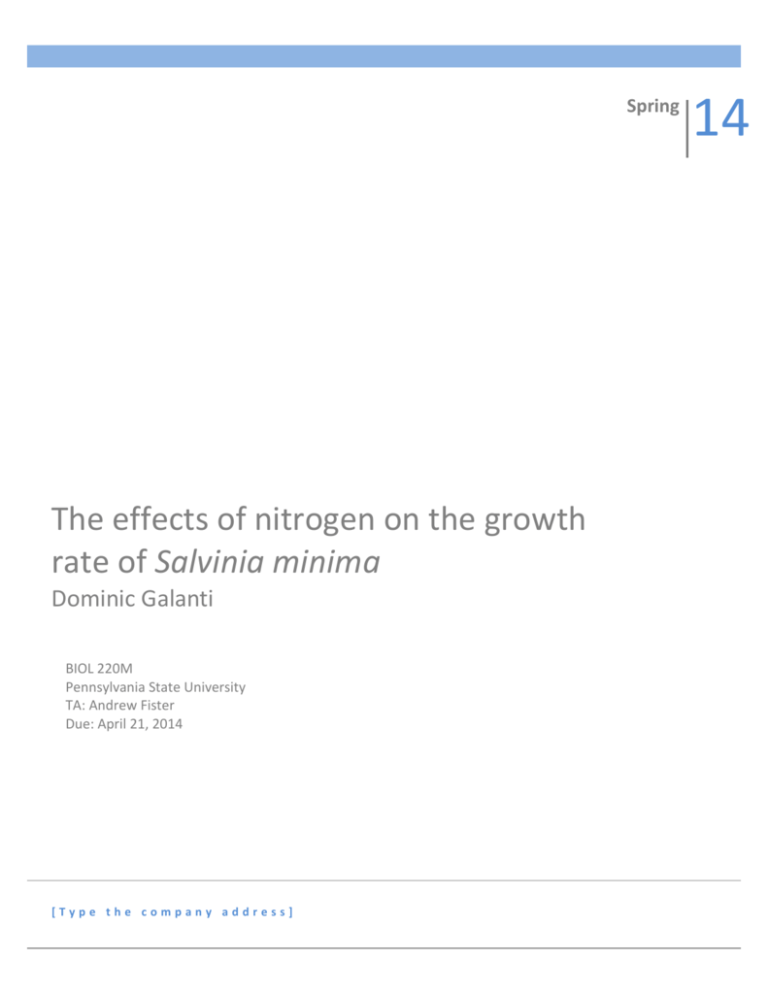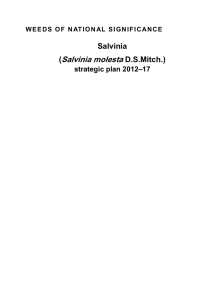File
advertisement

0 Spring The effects of nitrogen on the growth rate of Salvinia minima Dominic Galanti BIOL 220M Pennsylvania State University TA: Andrew Fister Due: April 21, 2014 [Type the company address] 14 [Type text] [Type text] Galanti, 1 Introduction With an increase in water pollutants human populous is often to blame for impure water throughout the world. The pollutants range from large solid masses of plastic to heavy metals and high levels of nitrates1. These come from common littering, which follows waterways that lead from streams to the ocean. Inevitably this affects all levels of the food chain. Many factories and sewage treatment plants are held to low standards and end up dumping large quantities into local water systems. In addition to this fertilizer runoff effectively raises nitrogen and phosphorus levels in the water, key nutrients for plant growth, which causes algal blooms in the water. These algal blooms can kill or weaken fauna and outcompete other flora2. In order to rectify waterway contaminants environmentalists incorporate phytoremediation into their work. Throughout these experiments scientists used different variables to determine growth rates in Lemna minor and Salvinia minima with a comparison to the factors found in polluted bodies of water3. Among all of the factors found in a real life scenario these experiments investigated the growth rates in increased ratios of either phosphorus or nitrogen along with competition between the two species. This experiment will take a primary focus on the phytoremediation abilities of Salvinia.minima and it’s growth rate in water with higher than normal nitrogen levels. Studies suggest that certain plant species uptake varying levels of nutrients as well as enduring with different fitness levels4. Through investigation of the fitness of Salvinia minima in nutrient levels equivalent to their typical growing [Type text] [Type text] Galanti, 2 environment and nutrient levels representative of waters with higher nutrient levels due to pollution, environmentalists will have a better understanding of Salvinia minima fitness in polluted waters and it’s applications in phytoremediation4. Due to Salvinia minima’s range of environmental tolerance it can be predicted that with an increase in the available nitrogen Salvinia will have a higher growth rate and carrying capacity. Materials and Methods1 This experiment took place over a matter of 5 weeks. The first week was focused on preparing the cultures. To set up there were 5 dishes; two to act as controls for growth with an artificial pond water media, one with 12 individuals and the other with 24 individuals of the species Salvinia minima. The dish with 24 individuals was considered the control for the nitrogen growth experiment. The remaining 3 dishes contained 24 individuals of Salvinia minima with water from the same source as the control but an additional 2 ml CaNo3 per dish. Each dish contained 10 oz. of water. When preparing dishes the quantity of Salvinia minima reflects the number of individuals, or each leaf set with a stem, not the number of leaves. On the Monday of each week an additional 2ml of CaNo3 was added per dish. In addition the dishes were watered 3 days of the week along with 2 days where the cultures were counted for thalli, number of leaves. Within the growing environment, a greenhouse at the Pennsylvania State University during March 2014 existed two species, Lemna minor and Salvania [Type text] [Type text] Galanti, 3 minima. These two species existed in separate containers for this experiment but were in the same greenhouse. The additional species, Lemna minor was used in other bioremediation experiments and could be used as a comparison to Salvinia minima in future experiments. The plants were not shaded and the daytime temperature within the greenhouse was set to 70 degrees although varying sunlight intensity could affect the surface temperature as this experiment was done in March. In addition to this particular experiment scientists combined data from similar bioremediation experiments to better understand each scientist’s specific experiment. The additional experiments included an identical experiment to this specific nitrogen growth variable with the substitution of phosphorus for nitrogen. The other experiments followed the two stated above substituting Lemna minor for Salvinia minima. The last experiment investigated the competition between the two species (Lemna minor and Salvinia minima). Unlike the nutrient experiments, which used the 24 individual dish as a control, the competition used the 12 individual dish as a control to compare to because the initial setup of these dishes included 12 individuals of each Lemna minor and Salvinia minima. Equations: Geometric rate of increase: λ=(Nt+1)/(Nt)=ermax Logistic Growth Equation: dN/dt=rmaxN[(k-N)/N] Lamda vs. N: y = -0.0231x + 6.6299 Surface Area Carrying Capacity Estimation: S.A.dish/S.A.thalli [Type text] [Type text] Galanti, 4 The above equations were used to determine growth rates, carrying capacities, and to generate the below models for the results. . Results Table 1: Growth of Salvinia Control Experiment 1-24 Salvinia Control Time (weeks) Number of Leaves 0 52 2 142 3 138 4 319 Table 1 is a collection of thalli counts of the control experiment over a 5-week period. Table 2: Growth of Salvinia with Nitrogen Experiment 2-24 Salvinia with Nitrogen Time (weeks) Number of Leaves 0 53 2 158 3 225.33 4 335 Table 2 shows the average number of leaves in three cultures of Salvininia minima with an increased nitrogen level per week. Table 3: Additional calculated values for the growth of Salvinia minima Time (weeks) Lambda Ln(N) Carrying Capacity(k) [Type text] [Type text] Galanti, 5 0 N/A 3.97 K by graph: 243.71 2 2.98 5.06 K by S.A.: 207.46 3 1.42 5.41 4 1.48 5.81 Table 3 shows growth values calculated given the leaf counts and population equations stated previously. Table 4: Final counts from other group experiments Group 1-12 1-24 1 2 3 Exp. Phytofighters 153 190 229 219 240 S+P Em’s Lems 326L 398L 54L 116S 42L 105L 76L 122S Comp CSLSACD 510 290 417 345 386 L+N When Life 198 623 916 962 998 L+P gives you Lemna Table 4 shows data collected from groups conducting like experiments in the fourth week of experiment. Figure 1:Scatterplot of Control Experiment of N vs. t Experiment 1: Control Salvinia-24 350 300 250 Experiment 1: Control Salvinia-24 200 150 Expon. (Experiment 1: Control Salvinia-24) 100 50 0 0 1 2 3 4 5 Figure 1 shows the exponential increase of Salvinia minima with respect to time in weeks. This shows experiment one which held a starting culture of 24 individuals with no nutrient variable. [Type text] Galanti, 6 [Type text] Figure 2: Scatterplot of experiment 2; Salvinia with excess nitrogen in N vs t Experiment 2: Salvinia w/ Nitrogen 400 350 300 250 Experiment 2: Salvinia w/ Nitrogen 200 150 100 50 0 0 1 2 3 4 5 Figure two exhibits the exponential increase of Salvinia minima with respect to time in weeks. This shows experiment two with a starting culture of 24 individuals and an increased nitrogen level. Figure 3: Ln(N) vs. t Experiment 2: Ln(N) vs. t 7 6 5 Experiment 2: Ln(N) vs. t 4 3 Linear (Experiment 2: Ln(N) vs. t) 2 1 0 0 1 2 3 4 5 Figure 3 represents the natural log of N, number of individuals, against time in weeks. Figure 4: Lambda vs. N [Type text] Galanti, 7 [Type text] lambda vs. N 3.5 3 2.5 2 lambda vs. N 1.5 y = -0.0231x + 6.6299 Linear (lambda vs. N) 1 0.5 0 0 50 100 150 200 250 Among these calculations are the carrying capacity estimations by surface area and by solving the equation of lambda vs. N.Figure one displays the collected data of the control dish, 24 individuals of Salvinia minima in artificial pond water, against t, time in weeks. This provides a baseline for the following experiment. Following this is the table showing growth with added nitrogen. With the higher results in this table it is clear that the water with a higher nitrogen level resulted in a higher growth rate and carrying capacity than the control. The last two graphs help to determine the growth rate with lambda and rmax calculations. Discussion The above data proves the hypothesis of an increased growth rate and carrying capacity as a result of a higher level of available nitrogen in the water. In a real world application this would correlate to higher numbers of Salvinia minima individuals in polluted bodies of water. With a higher concentration of plant individuals the nutrient uptake would be greater and bioremediation of the [Type text] [Type text] Galanti, 8 waterway would be achieved quicker. The actual carrying capacity is thought to be more than predicted by the surface area estimation. This can be accounted to thalli not being level and having degrees of translucency allowing more individuals to propagate. Although this experiment did not quantify the nutrient uptake of Salvinia minima, due to an increased fitness of the species it is expected to uptake the nutrient. Future experimentation should include the water to be monitored for nutrient as time passes and graphs to be constructed showing the correlation of water nutrient concentration vs. time. If both species are allowed to reach carrying capacity in this future experiment ecologists will have a better understanding of which plant to use in the bioremediation setting whether the target is phosphorus or nitrogen. This experiment is repeatable but varying results should be expected due to error. This experiment was done in March of 2014 at a temperature-controlled greenhouse at the Pennsylvania State University. With varying light intensities at this season and variable weather patterns for this particular year repetitions of this experiment are expected to vary. In addition to weather, pests were found in the dishes, which may have been either competing, algae, or preying upon, fruit flies. Both of these factors would limit the growth rate of the plant and the algae could lower the carrying capacity of Salvinia minima. This may be done by a reduction in sunlight, use of resources, or as a media to harbor diseases, which the fruit flies could introduce into the population. In conglomeration with the other scientists who conducted the relatable experiments it was found that the nutrient phosphorus also increased both the [Type text] [Type text] Galanti, 9 carrying capacity and growth rate for both species. As for the competition experiment, Salvinia minima was shown to outcompete Leman minor in the given time period. References 1Hass, C.A., D. Burpee, R. Meisel, and A. Ward. 2013. A Preliminary Study of the Effects of Excess Nutrients and Interspecies Competition on Population Growth of Lemna minor and Salvinia minima In A Laboratory Manual for Biology 220W: Populations and Communities. (Burpee, D. and C. Hass, eds.) Department of Biology, The Pennsylvania State University, University Park, PA. 2Beiswenger, J. M. 1993. Experiments To Teach Ecology. A Project of the Education Committee of the Ecological Society of America. Ecological Society of America, Tempe, AZ. pp. 83-105. 3Dhir, Bhupinder, 2009. Salvinia: an Aquatic Fern with Potential Use in Phytoremediation. Department of Genetics, University of Delhi South Campus, New Delhi 110021, India. Environ. We Int. J. Sci. Tech. 4 (2009) 23-27 4Núñez-López RA, Meas Y, Gama SC, Borges RO, Olguín EJ. 2008. Leaching of lead by ammonium salts and EDTA from Salvinia minima biomass produced during aquatic phytoremediation. 154(1-3):623-32. Epub 2007 Nov 4









